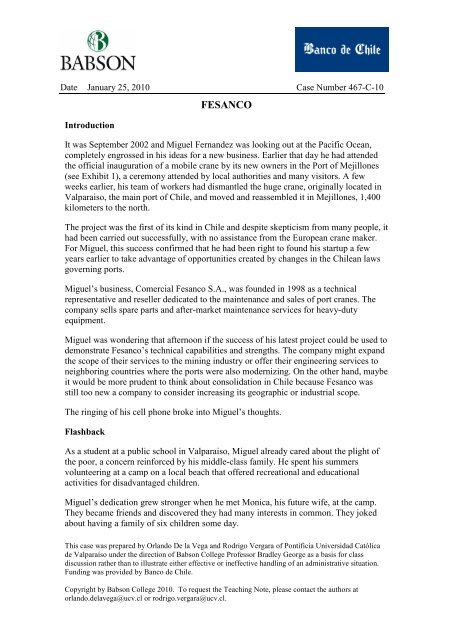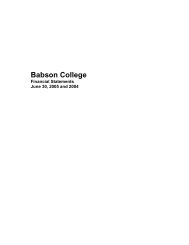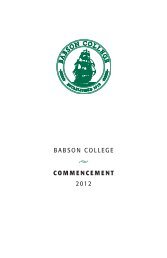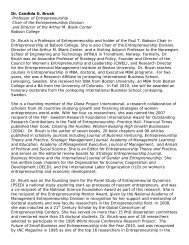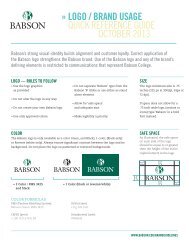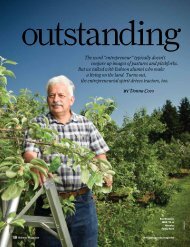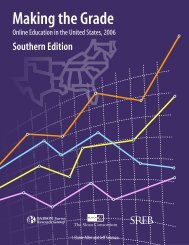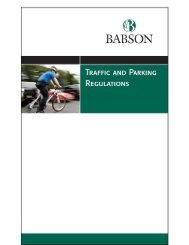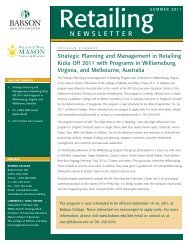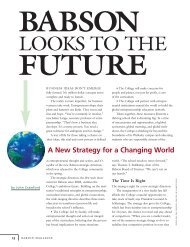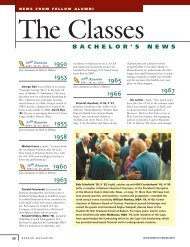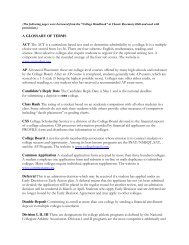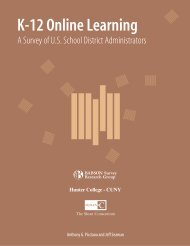fesanco (pdf) - Babson College
fesanco (pdf) - Babson College
fesanco (pdf) - Babson College
You also want an ePaper? Increase the reach of your titles
YUMPU automatically turns print PDFs into web optimized ePapers that Google loves.
Date January 25, 2010 Case Number 467-C-10<br />
Introduction<br />
FESANCO<br />
It was September 2002 and Miguel Fernandez was looking out at the Pacific Ocean,<br />
completely engrossed in his ideas for a new business. Earlier that day he had attended<br />
the official inauguration of a mobile crane by its new owners in the Port of Mejillones<br />
(see Exhibit 1), a ceremony attended by local authorities and many visitors. A few<br />
weeks earlier, his team of workers had dismantled the huge crane, originally located in<br />
Valparaiso, the main port of Chile, and moved and reassembled it in Mejillones, 1,400<br />
kilometers to the north.<br />
The project was the first of its kind in Chile and despite skepticism from many people, it<br />
had been carried out successfully, with no assistance from the European crane maker.<br />
For Miguel, this success confirmed that he had been right to found his startup a few<br />
years earlier to take advantage of opportunities created by changes in the Chilean laws<br />
governing ports.<br />
Miguel’s business, Comercial Fesanco S.A., was founded in 1998 as a technical<br />
representative and reseller dedicated to the maintenance and sales of port cranes. The<br />
company sells spare parts and after-market maintenance services for heavy-duty<br />
equipment.<br />
Miguel was wondering that afternoon if the success of his latest project could be used to<br />
demonstrate Fesanco’s technical capabilities and strengths. The company might expand<br />
the scope of their services to the mining industry or offer their engineering services to<br />
neighboring countries where the ports were also modernizing. On the other hand, maybe<br />
it would be more prudent to think about consolidation in Chile because Fesanco was<br />
still too new a company to consider increasing its geographic or industrial scope.<br />
The ringing of his cell phone broke into Miguel’s thoughts.<br />
Flashback<br />
As a student at a public school in Valparaiso, Miguel already cared about the plight of<br />
the poor, a concern reinforced by his middle-class family. He spent his summers<br />
volunteering at a camp on a local beach that offered recreational and educational<br />
activities for disadvantaged children.<br />
Miguel’s dedication grew stronger when he met Monica, his future wife, at the camp.<br />
They became friends and discovered they had many interests in common. They joked<br />
about having a family of six children some day.<br />
This case was prepared by Orlando De la Vega and Rodrigo Vergara of Pontificia Universidad Católica<br />
de Valparaíso under the direction of <strong>Babson</strong> <strong>College</strong> Professor Bradley George as a basis for class<br />
discussion rather than to illustrate either effective or ineffective handling of an administrative situation.<br />
Funding was provided by Banco de Chile.<br />
Copyright by <strong>Babson</strong> <strong>College</strong> 2010. To request the Teaching Note, please contact the authors at<br />
orlando.delavega@ucv.cl or rodrigo.vergara@ucv.cl.
Miguel’s high school years, from 1969 to 1973, were a period of great social and<br />
political upheaval in many Latin American countries, including Chile. Miguel became<br />
deeply introspective and for a time lost his religious faith. He wondered why there was<br />
so much hatred and intolerance in the world. He decided that in such a chaotic<br />
environment, the only way to achieve success was through hard work and integrity.<br />
Toward the end of 1973, a military government took over in Chile and ruled until 1998.<br />
Miguel began studying for a degree in mechanical engineering at the Pontificia<br />
Universidad Catolica de Valparaiso in 1974. He was the first member of his family to<br />
have the chance to pursue a professional career.<br />
At this time, Miguel (like other students in Chile) was focused only on his studies. But<br />
by his fourth year at the university, he felt that some of the classes given by his<br />
professors did not address his interests, and he decided to take the initiative, with the<br />
consent of the school’s administration. Miguel and some of his classmates created the<br />
Professional Extension Group (PEG). Their goal was to develop a roundtable forum in<br />
which undergraduates could create workshops and discuss new topics and issues related<br />
to mechanical engineering.<br />
The dean warned Miguel that group activities at universities, especially political ones,<br />
were forbidden, and that starting PEG would be risky. Miguel responded that he was<br />
well aware of the restrictions. He knew it was a risk both for himself and the university,<br />
but he believed the school should trust him. He said, “Our purpose is professional, but it<br />
is also cultural. People are made up of body, mind, and spirit, and all these dimensions<br />
deserve attention. This initiative is a good way to add value across those dimensions.”<br />
Despite the negative predictions of his classmates, Miguel received permission to start<br />
PEG at the university. Miguel and the other founders were extremely enthusiastic. They<br />
invited entrepreneurs and executives to their conferences and seminars. They also<br />
organized professional workshops where undergraduates analyzed new projects and<br />
watched films about mechanical engineering and specialized foreign documentaries.<br />
PEG became well known at the university, and soon professors also joined PEG and<br />
became active in discussion forums.<br />
The following year, the dean asked Miguel to become the president of his class, but he<br />
said no because he had been appointed to the position rather than elected by his<br />
classmates in a democratic election. In the end, however, he accepted the responsibility<br />
because his fellow students wanted him as their leader and pressed him to take the job.<br />
As president, he created teams of students that enthusiastically developed programs, and<br />
he invited students to participate in social and spiritual reflection activities.<br />
Early jobs<br />
Miguel graduated in 1980 and began his first professional experience at Flexshoes, a<br />
small company that made shoes. Miguel was in charge of machinery maintenance, and<br />
in his free time he talked to workers and learned about their problems and goals for the<br />
future. After thinking about how to better manage employees, Miguel said to his boss<br />
one day, “I’m convinced that the only way to achieve success in business is to develop a<br />
motivated team of workers who are totally focused on quality.”<br />
2
This was the same year that, at the age of 23, he decided to marry his girlfriend Monica<br />
and start a family. According to Miguel, that was “the most important startup company”<br />
he ever created.<br />
After two years at Flexshoes, Miguel felt that its organizational climate and culture were<br />
substandard, and since the people in charge did not want to change, he found another<br />
job. He began working at Comercial Maipo as an engineer in training in January 1981,<br />
just as the company was developing a new business unit for the import and sales of<br />
vehicle batteries. Comercial Maipo acted as a representative for global producers like<br />
Japan Storage Battery Company and PT Century Batteries Indonesia. Miguel learned<br />
everything he could about this business. He was involved with importing products and<br />
with creating a distribution network around the country. In 1983 he was promoted to<br />
manager of logistics. Although Miguel enjoyed this job, by 1985 it was becoming<br />
monotonous, and once again he started thinking about a different professional setting.<br />
The port industry<br />
In 1986 Miguel was hired by Agunsa, a shipping agency with offices along the entire<br />
Chilean coast. He began as the engineer in charge of maintenance for heavy-duty<br />
machinery in the Port of Valparaiso.<br />
During his frequent visits to various ports, Miguel met people involved in fieldwork.<br />
The person who most attracted his attention was Rene Segura, the maintenance engineer<br />
of Ultraport. Rene always knew the latest developments in technology and was<br />
considered the most skilled specialist in the maintenance of high-tech machines.<br />
Unfortunately Rene worked for a competitor.<br />
Miguel enjoyed this new job, and after few years he was promoted to chief maintenance<br />
officer in charge of high-performance machinery, equipment, and the boats operating in<br />
every Chilean port. The CEO of Agunsa often complimented Miguel on his ability to<br />
build relationships and on his sales skills. He even used to joke that Miguel should get a<br />
job in sales. This particular comment intrigued Miguel, and in 1994 he decided to study<br />
for a graduate degree in business administration, with a focus on marketing and finance,<br />
at the Pontificia Universidad Catolica de Valparaiso so he could strengthen his<br />
management skills.<br />
Miguel’s schedule was on overload during those years. He worked all day, took classes<br />
at night, and spent the weekend studying and completing assignments. The only time he<br />
saw his children was when he drove them to school in the morning. At their school he<br />
met Ricardo San Martin, an attorney specializing in maritime law who had litigation<br />
experience in insurance claims for vessels and cargoes. They soon established a<br />
friendship. Both worked in the maritime and port industry, they had children at the same<br />
school, and every morning they ate breakfast together at a restaurant near the school.<br />
The Chilean economy had been growing during the previous ten years by about six<br />
percent annually, and the future looked promising because of the commercial free trade<br />
agreements that Chile was signing with United States, Canada, several countries in<br />
Southeast Asia, and the European Union. Judging by what Miguel saw in various ports,<br />
he thought the Chilean port model was inefficient and outdated. The cargo movement<br />
had grown (see Exhibit 2), and the system was unable to face the challenges and<br />
3
dynamism that the global economy demanded. He predicted to Ricardo that, sooner or<br />
later, the port system would have to modernize, and there were no private local<br />
companies to help the port administrators find services and resources to maintain their<br />
heavy-duty equipment. Ricardo had heard that the Chilean authorities were willing to<br />
privatize the main Chilean ports under long-term concession agreements, and that the<br />
government would invite domestic and foreign private companies to take over port<br />
management. This work would be done via a new law affecting ports. Miguel’s<br />
reaction to this news was, “This is an opportunity that someone should definitely<br />
prepare for!”<br />
As chief maintenance officer at Agunsa, Miguel was familiar with the entire<br />
marketplace of heavy-duty equipment, and he had worked with several global providers.<br />
Gottwald Port Technology, a German company, was the main provider of equipment<br />
and spare parts for Agunsa because of the high quality of its products and services.<br />
Miguel knew Heinz Hinrichs, the sales director at Gottwald, and Andreas Moeller, the<br />
sales director for the Americas, who were interested in increasing their sales<br />
representatives around the globe.<br />
Gottwald Port Technology, based in Düsseldorf, Germany, was the world’s leading<br />
supplier of mobile harbor cranes (HMK series). The company produced a<br />
comprehensive range of HMK cranes with lifting capacities of up to 120 tons and a<br />
radius of up to 56 meters, in addition to rail-mounted portal harbor cranes (HSK series).<br />
Gottwald also offered services for terminal operators, from conceptual design and<br />
operational layout, to basic engineering of equipment and systems, to automated guided<br />
vehicles (AGV) and automated container stackers (ACS). The company had a<br />
workforce of around 700 employees in Düsseldorf at the time, and the profit for fiscal<br />
year 1999 was around $200 million.<br />
In the course of his work, Miguel often supervised projects to upgrade and modernize<br />
the equipment and logistical processes at Agunsa. He worked with Rolando Ramos,<br />
who was in charge of the planning and control of logistics and operations. Rolando had<br />
a degree in business administration, and he was known at Agunsa as a methodical and<br />
organized professional who was good at strategic planning and management. Because of<br />
their complementary skills, he and Miguel were a successful team.<br />
The Asian Crisis<br />
While Miguel was working at Agunsa, the Asian Crisis started in Thailand in 1997 and<br />
quickly spread to Indonesia, Korea, Japan, Hong Kong, Malaysia, Singapore, the<br />
Philippines, and Indonesia (see Exhibit 3).<br />
The effects of the Asian Crisis were felt in Latin America starting in October 1997,<br />
when Asia’s currency devaluations started pressuring other markets, which in turn<br />
transformed a regional drama into a broader crisis of emerging economies. Latin<br />
America was affected through two main channels: finance and trade. As a result, Latin<br />
American trade balances with Asia deteriorated. The price of essential goods like<br />
copper and petroleum—the primary Latin American exports—declined significantly in<br />
1997 due, in no small measure, to the reduction of the Asian demand. Chile was<br />
especially exposed because 38.12 percent of its exports were to Asia (see Exhibit 4).<br />
4
Changing conditions<br />
In November 1997, Agunsa started a reengineering process and Miguel had to leave the<br />
company. During his last days at the company, he sent faxes to machinery suppliers to<br />
explain his situation and introduce his replacement. Within a few minutes he received<br />
responses from those suppliers, in particular from Heinz Hinrichs, who wished him well<br />
in his future projects and asked if he would be interested in working on new projects in<br />
Chile as a reseller for Gottwald.<br />
One month later, on December 19, 1997, Port Law number 19.542 was published in the<br />
official Chilean newspaper. The purpose of this law was to modernize the eleven largest<br />
Chilean ports (see Exhibit 5) by means of accelerated development of the state-owned<br />
ports by improving efficiency and reducing costs. This process would need private<br />
investment in order to enhance the competitive position of Chilean foreign trade.<br />
In conjunction with this new law, the public company EMPORCHI, which then, as now,<br />
managed all Chilean ports, published a master plan to implement the new law according<br />
to clear specifications about the conditions that private companies and consortiums had<br />
to present in their bids. The proposals had to be focused on the modernization of<br />
facilities and equipment, and Miguel knew there was no local company with the<br />
capability to sell port machinery and provide maintenance services to private operators<br />
in the new terminals.<br />
The foundation<br />
Miguel’s first step after leaving Agunsa was to propose a new kind of business to a few<br />
large companies. His idea, derived from the new law of ports, was to provide services to<br />
the new private port operators related to the maintenance of their heavy-duty machinery.<br />
The proposal was intended to be a joint venture. Miguel would provide the talent,<br />
knowledge, and skills to manage the project, while the established company would<br />
provide its resources, organization, and market positioning.<br />
Unfortunately companies were not interested in Miguel’s proposal, probably because of<br />
the negative effects of the Asian Crisis. This situation made him rethink his project.<br />
Maybe his idea was not as good as he believed. Nevertheless, Miguel was so convinced<br />
the project could succeed and so sure the opportunity should be pursued that he kept<br />
looking for a partner. When he still failed to find one, he decided to create his own.<br />
Miguel needed a lawyer to set up the company, and he decided to talk to his friend<br />
Ricardo San Martin. With typical enthusiasm, Miguel said, “This is a great opportunity<br />
and I can’t walk away from it. You know I have the experience and expertise to<br />
succeed.” Aware of the current economic crisis, Ricardo advised that this was not the<br />
right time to start a business, and he tried to convince Miguel to proceed in stages,<br />
beginning with a small consultant’s office.<br />
Miguel responded with a proposal. “The services we offer to large companies have to be<br />
developed by a relatively large provider. I don’t want to be just a reseller of cranes and<br />
spare parts. I want to set up a publicly traded company. Bad economic times can be<br />
good for startups, and I will create this company alone, unless you want to share the risk<br />
with me.”<br />
5
Miguel’s invitation was accepted, and on March 19, 1998, Comercial Fesanco S.A. was<br />
founded. Miguel chose this particular day in which Catholics honor St. Joseph the<br />
Worker, who was designated as the protector of the personnel. As his initial equity,<br />
Miguel invested US $10,000 he had received as a severance payment from Agunsa.<br />
Ricardo agreed to invest $4,000 and Miguel’s wife Monica added $1,000 from her<br />
savings. Fesanco’s first office was in Miguel and Monica’s house. During this stressful<br />
period, Monica was the mainstay for her family and also for her husband’s<br />
entrepreneurial adventure.<br />
Lemonade<br />
In the ensuing months, the Asian Crisis continued to hammer the worldwide economy.<br />
The demand for consulting services and spare parts declined precipitously. Ricardo was<br />
ready to end the Fesanco project, but Miguel was convinced that the economic crisis<br />
would force them and the entire industry to improve their administrative and operational<br />
efficiency.<br />
One year after it was founded, Fesanco was suffering from a serious cash flow deficit.<br />
Miguel was unwilling to use his family’s house as collateral for loans. By that time, he<br />
and Monica had the six children they had dreamed of when they were young. Instead<br />
Miguel made a phone call to Heinz Hinrichs, the sales director of Gottwald, to ask if the<br />
company would hire him as its official representative in Chile. He proposed to be their<br />
exclusive agent for $2,000 monthly for a period of two years.<br />
The timing was not ideal; the effects of the crisis were serious, especially for companies<br />
involved in foreign trade. Miguel thought that the worst-case scenario would be an<br />
immediate no. Instead Heinz said he would analyze the proposal with Andreas Moeller.<br />
Within a few days, Heinz and Andreas sent a fax with a positive response. It was a nice<br />
surprise when Miguel saw that the entire $24,000 had been immediately deposited in his<br />
bank account as a sign of their confidence in him.<br />
New beginnings<br />
In August of that year (1999), the ports of Valparaiso, San Antonio and San Vicente<br />
were privatized, in a concession model for a period of twenty years. Two months later,<br />
the Port of Mejillones was also privatized in the same way.<br />
The continuing Asian Crisis meant that the following year was still bad for sales (see<br />
Exhibit 6), and Miguel watched each dollar as if it were his last. Fesanco was close to<br />
bankruptcy when, in November of 2000, they received an urgent phone call from TPS,<br />
the company that had the concession for the Port of Valparaiso. The voice on the other<br />
end of the line said, “Miguel, we need to buy and assemble a port crane right away. Can<br />
you help us solve this problem because we’re in trouble. The only person who can do it<br />
is you, so please do your best. If you can solve our problem, the purchase order is<br />
yours.”<br />
Miguel called his contacts in Europe and America and by the end of the day, with the<br />
help of Andreas Moeller, he was able to tell TPS that a crane was available and the<br />
problem was solved.<br />
6
Fesanco’s responsiveness was recognized and valued in the marketplace. Three months<br />
later a different customer asked Miguel to find two new cranes for the port of San<br />
Vicente (operated by SVTI). However, there was one stipulation: Fesanco had to work<br />
on the assembly and preventive maintenance of the equipment.<br />
With no time to spare and grateful for the vote of confidence, Miguel accepted the<br />
challenge even though Fesanco did not have the necessary technical team to accomplish<br />
the project. He remembered Rene Segura, the maintenance engineer he had worked with<br />
at Ultraport, and offered him the position of operational manager. Rene accepted and<br />
convinced two other technicians who had worked with him to join Fesanco as well.<br />
Together they started hiring a small team of technicians and experienced workers.<br />
Gottwald also gave them technical support and assistance, and Miguel was able to lease<br />
an office near the port areas so he could work away from his house.<br />
Focus on quality<br />
During a routine inspection at the SVTI project, Miguel observed some deficiencies in<br />
the assembly operation. He used this as an opportunity to emphasize the importance of<br />
doing a job well and the advantage of high-quality service. He called together his<br />
employees and spoke to them.<br />
You guys don’t know how lucky you are. You should appreciate how important<br />
you are and how necessary your job is for yourselves and our company. These<br />
days many people don’t have a job, and the unemployment rate is growing. This<br />
job is a gift from God, so we have to be thankful and do it right.<br />
Please do your jobs well from the beginning and pay attention to each and every<br />
detail of the project. Together we can bring value to our customers, and this will<br />
be the basis of our success and the reason our customers come to us. This work<br />
is our way of contributing to society.<br />
Please believe that the concern of this company is the value of each person<br />
rather than profit. Our mission is to hire the best people so they can work in a<br />
pleasant atmosphere and ensure the well-being of their families. We offer<br />
training and professional development, and we encourage spiritual growth. In<br />
short, we want to ensure the growth of the whole person.<br />
These words, spoken at just the right moment, made a positive impact on the Fesanco<br />
workers, and the technical project was finished the right way in spite of its low<br />
profitability.<br />
Beginning of the takeoff<br />
At the beginning of 2002, Ultraport and Complejo Portuario de Mejillones (CPM), the<br />
new private port operator of Mejillones, hired Fesanco to dismantle a crane at the<br />
Valparaiso port. This crane also had to be taken to Mejillones for its reassembly. The<br />
one stipulation was that Rene Segura had to be the manager in charge of the entire<br />
operation.<br />
The business began growing and Miguel thought it was time to hire someone to<br />
improve planning and control in the company and develop a pricing system to enhance<br />
7
profitability. Who better to do this job than Rolando Ramos, who accepted a part-time<br />
position in the company?<br />
With Rolando and Rene onboard, the Mejillones project got off to a good start, with<br />
solid technical and financial planning.<br />
New opportunities were on the horizon. Rolando kept in touch with colleagues at<br />
Agunsa who were working in Ecuador and Peru. They told him that the main ports in<br />
those countries were going to be tendered soon (see Exhibits 7 and 8). Rolando and<br />
Miguel visited people in those countries to see if there were any opportunities for<br />
Fesanco and to look for local partners. Since CPM was a subsidiary of the Codelco<br />
Mining Company, the largest copper mine in the world and the main user and customer<br />
of the Port of Mejillones, Miguel also kept thinking about the possibility of making a<br />
foray into that industry (see Exhibits 9 and 10).<br />
The Mejillones project ended in September 2002, a total success in terms of Ultramar’s<br />
requirements for timing, budget, and quality, and the crane was officially handed over to<br />
the customer. Top executives from Ultraport, CPM, and Codelco, as well as local<br />
authorities and the head of Gottwald for Latin America, attended the inauguration<br />
ceremony in the Port of Mejillones. After the ceremony, Miguel looked out at the sea of<br />
Mejillones, slashed by the silhouette of the newly assembled crane, and thought about<br />
the possibilities for Fesanco. He asked himself, “How can we take advantage of<br />
opportunities without enough money to invest? Leaving the country to market our<br />
services is difficult, and the mining industry is very competitive in Chile. On the other<br />
hand, the economic crisis could end at any time, and this may be a good time to expand.<br />
But I’m not sure my European partner feels the same way.”<br />
His thoughts were interrupted by a phone call. He heard a familiar voice with a German<br />
accent. “News travels fast,” he thought, as he said hello to Andreas Moeller. Andreas<br />
congratulated him on the finished project and then posed the following question: “Do<br />
you remember that several years ago I suggested the possibility of creating subsidiaries<br />
in Chile, Peru, Brazil, and Ecuador? Well, my friend, don’t you think it’s time to untie<br />
your boat and let sail it out to sea, with your destination being to create Gottwald Peru<br />
and Gottwald Ecuador?”<br />
8
Case preparation questions<br />
1. What is the problem (the dilemma) for Miguel in this case?<br />
2. Which of the creation-oriented behavior principles of entrepreneurship (bird-inhand,<br />
crazy quilt, affordable loss, and lemonade) is the most relevant in this case? Why?<br />
3. What would you do next in the position of Miguel Fernandez?<br />
Use the following framework to analyze the pluses and minuses of the challenges and<br />
opportunities.<br />
MARKET<br />
PERSONAL<br />
FEASIBILITY VALUE<br />
Is it doable?<br />
Technical feasibility<br />
Market feasibility<br />
Can I do it?<br />
What does it take?<br />
Who else do I need?<br />
9<br />
Is it worth doing?<br />
Financial feasibility<br />
Affordable loss<br />
Do I want to do it?<br />
What excites me about it and why?<br />
Source: Dew, Read, Sarasvathy, Wiltbank, Ohlssn, “Effectuation in Action, Work in Progress”, March 2009.
Exhibit 1: The Gottwald HMK 280E mobile crane installed in Port of Mejillones<br />
10
Exhibit 2: Chilean foreign trade<br />
11
Exhibit 3: Growth of real GDP during the Asian Crisis<br />
12
Exhibit 4: Latin American exports to Asia in 1997<br />
13
Exhibit 5: Largest Chilean ports<br />
14
Exhibit 6: Income and Net Profit at the beginning of Fesanco<br />
15
Exhibit 7: Latin-America port laws and reforms<br />
16
Exhibit 8: Port Efficiency Index 2002 versus GDP per Capita<br />
17
Exhibit 9: Most relevant copper producers in 2002<br />
18
Exhibit 10: Mine project investments for 2003-2004<br />
19


